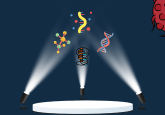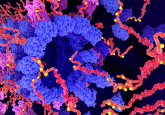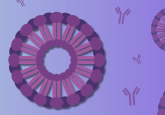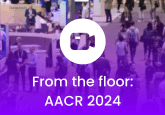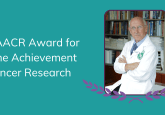AACR 2024: key themes, takeaways and triumphs from Program Co-Chair Christina Curtis

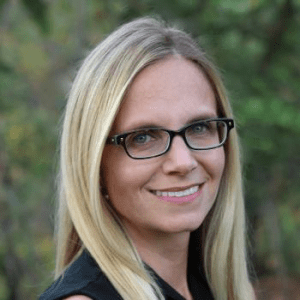 Christina Curtis (left) is the RZ Cao Professor of Medicine Genetics and Biomedical Data Science at Stanford University (CA, USA), where she also directs artificial intelligence, cancer genomics and breast cancer translational research. Christina is one of this year’s AACR Program Chairs; the first year the role has been split between two people to ensure that the full spectrum of cancer research is represented in the program.
Christina Curtis (left) is the RZ Cao Professor of Medicine Genetics and Biomedical Data Science at Stanford University (CA, USA), where she also directs artificial intelligence, cancer genomics and breast cancer translational research. Christina is one of this year’s AACR Program Chairs; the first year the role has been split between two people to ensure that the full spectrum of cancer research is represented in the program.
On the last day of the conference, we caught up with Christina to find out what drove her selections for the program, her key takeaways from the event, what she found most exciting at the conference and her perspective on the current landscape of cancer research.
Why was computational biology a significant focus at this year’s AACR?
As a computational biologist, I had a personal interest in elevating data science and highlighting the impact that this field can have. In the field, many of us have felt that we’re on the cusp of seeing real transformation because of the increased availability of data. This includes data created with contemporary high-throughput molecular techniques that we can increasingly deploy to profile experimental models and patient samples at unprecedented resolution.
The ability to leverage spatial and single-cell techniques to profile patient samples is beginning to transform our understanding of the mechanisms of disease biology, progression and resistance. It also paves the way for the development of new biomarkers to improve the stratification of patients for better prognosis and prediction of response to therapy. There were several sessions highlighting advances in spatial biology and new tools to look in situ at tissue within their native context without having to dissociate those cellular populations. This approach allows us to look at tumors in relation to their surrounding microenvironment, which is quite exciting because there is still a lot of discovery to be done in this arena.
 Machine learning approaches for spatial omic data analysis
Machine learning approaches for spatial omic data analysis
We caught up with Jeremy Goeks at AACR 2024 to discuss his lab’s work, get best practice tips for collecting and analyzing spatial omic data and how the field can progress in the future.
While whole genome sequencing is not a new technique, the vast majority of available cancer datasets still only profile a small portion of the coding region of our genomes, also known as an exome. Much remains to be learned about non-coding elements, as well as the role of large-scale structural rearrangements, using long-read sequencing technologies.
With all these technological developments, new computational methods are required to analyze and process the vast quantities of data that arise from them. When we think about data science, this is a broad area spanning statistics, computational biology and algorithmics, as well as machine learning (ML) and artificial intelligence (AI). Some of the approaches have been around for quite some time, but are just now being applied to new data types.
For example, with the increasing volumes of histopathological data, it is possible to train ML models to predict molecular subtypes. Indeed, there has been an explosion of research in digital pathology and I expect we will continue to see this mature.
While pathology data are abundant, its worth stressing that for many questions, we still lack sufficient clinically annotated data to answer key questions. Hence, while new technologies allow for data generation at unprecedented throughput, data are still often rate-limiting in oncology. Given the growing interest in data science and AI in all domains, this was an opportune time to engage the global cancer research community in this dialogue.
How did the sessions at AACR 2024 reflect this focus?
We sought to elevate data science broadly across many of the sessions and domains by showing how it allows new insights into cancer origins and disease biology, as well as precision oncology.
We also wanted to showcase the potential of the field and how these methods allow researchers to cut across disciplines. Really, there is a convergence of cancer biology and precision oncology in trying to solve distinct problems that inform one another. Some of these approaches can ultimately be scaled, potentially to the population level. We wanted the sessions to reflect this convergence.
We also wanted to ensure that the program presented a balanced view of the vast potential of new approaches and their accompanying challenges. This is particularly important when it comes to AI/ML. Given the hype, there is a very real need to better validate AI and ML methods before they can be used in a routine clinical fashion.
And so, this morning’s session, entitled ‘AI at the Interface’, sought to showcase how we can leverage different data types, the need for large-scale datasets and the critical aspect of evaluating how well new methods generalize across populations. This session also addressed how AI/ML approaches are being used to advance patient stratification and the critical path to validating novel algorithms for clinical use.
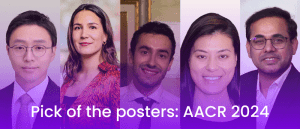 Pick of the posters: AACR 2024
Pick of the posters: AACR 2024
At AACR 2024, we explored the poster hall to pick out the posters that would interest the BioTechniques reader and those we found delivered the most interesting or surprising findings.
Were there any presentations that particularly interested you or delivered on your focus for this year’s conference?
The opening plenary set the scene really well, covering the use of computational biology and AI methods to interpret biological data and to inform drug discovery. Aviv Regev (Genentech, CA, USA) gave a powerful introduction to this session including how these kinds of approaches bring us into a lab in the loop perspective: considering that it’s not just the data production, we actually need to validate and analyze the data and methodologies. This set data science at the forefront of attendees’ minds as they attended the rest of the conference.
We then heard about computational pathology and how it can help us learn from routine pathology (Hematoxylin and Eosin) data. This approach offers the potential to infer molecular features from clinical images, a type of data that is abundant and available in hospitals around the world. This took us from the extreme of needing high dimensional data as the input to computational applications to “Well, jeez, images. We can compute on those too.”
Then the other two plenary speakers, Ben Cravatt (Scripps Research, CA, USA) and, Carolyn Bertozzi (Stanford University, CA, USA), showcased where the fields of drug discovery are going and the vast potential we have to design far more powerful probes with which to target aspects of biology previously seen as ‘undruggable’, such as transcription factors.
What were some of the challenges of delivering both a computational focus and a well-balanced program, covering all aspects of cancer research?
To touch on all those different areas was challenging. We covered several broad domains in the opening plenary, but that was just the tip of the iceberg. We sought to focus on the intersection of fields for as many sessions as possible by including speakers with different expertise and cross-cutting research. In this way, we could illuminate points of convergence across domains, while also threading the needle from basic sciences through to computational and clinical research. Hopefully, this prompted the audience to think about cancer in a way they may not have before.
Another challenge for the field more broadly is thinking about the need for representative and diverse populations in cancer datasets. This comes back to patient participation in biobanks and in clinical trials, which, in turn, feeds back into these growing knowledge networks. We don’t yet have enough data on diverse populations globally. Moreover, there are important considerations for data privacy and protection, as well as for data sharing. This is ever important as we need to overcome barriers to progress and ensure that discoveries benefit ALL patients.
While we’re seeing increased emphasis on translation because of the advances we just discussed, it’s critical to appreciate that fundamental scientific discovery is foundational for advances in precision oncology. For this reason, we felt that it is important that the many facets of basic science be represented at the AACR Annual meeting, while showcasing points of connection between them.
 Meet the pioneer of cancer immunotherapies
Meet the pioneer of cancer immunotherapies
Steven Rosenberg recently won the 2024 AACR Award for Lifetime Achievement in Cancer Research, and we got the chance to sit down with him to talk about his fascinating career and the techniques that have shaped it.
Which technologies or fields surprised you at this year’s event?
That’s a tough one. There are so many advances. I remain excited about the developments in spatial biology, which were highlighted in several sessions. For example, there was a plenary session that showcased technologies to study the tumor microenvironment in tissue context, from spatial transcriptomics and proteomics to post-translational modifications.
Another session examined the use of these and other tools to understand lethal metastatic spread in patient samples and experimental models. The occult metastatic process has remained elusive, and yet we must better understand it if we aim to circumvent disease progression.
What are three key things that you would like people to take away from this year’s conference?
I hope that the program showcased the numerous opportunities for intersection and convergence across disciplines. After all, cancer is a systemic disease and we need to start to view it as such.
Technological advances stand to inform our fundamental understanding of disease as well as to advance clinical translation. However, much work remains to be done to validate these new techniques and the insights they afford and to assimilate this information to test new hypotheses, develop robust diagnostics and novel therapeutic strategies. This will necessitate rigorous data analytic techniques.
I think the field is at an inflection point. However, harnessing these technological breakthroughs for patient benefit will require deep collaboration and necessitates engagement from multiple stakeholders. This is why a meeting of this caliber and scope is so important. AACR has and will continue to play a pivotal role in propelling science, fueling collaboration, and advancing policy that improves cancer diagnosis and treatment globally, while paving the way for earlier interventions and prevention.
The opinions expressed in this interview are those of the interviewee and do not necessarily reflect the views of BioTechniques or Taylor & Francis Group.
